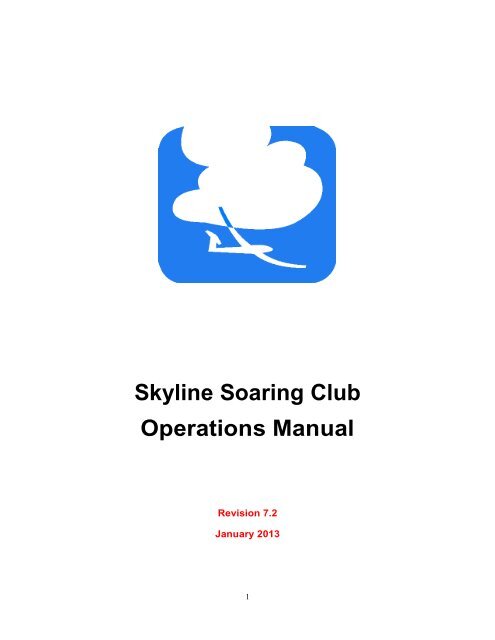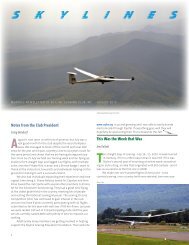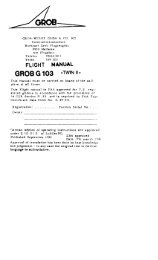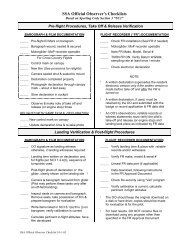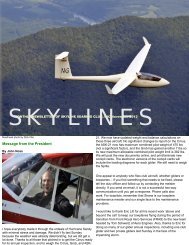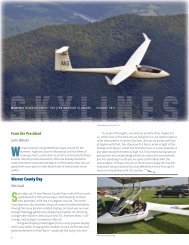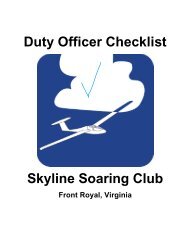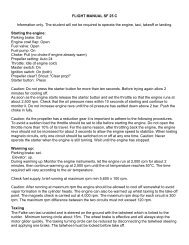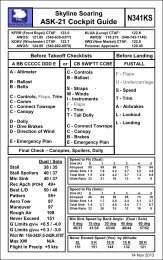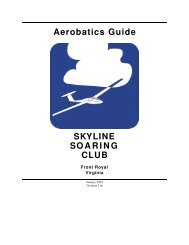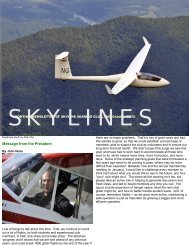Skyline Soaring Club Operations Manual
Skyline Soaring Club Operations Manual
Skyline Soaring Club Operations Manual
You also want an ePaper? Increase the reach of your titles
YUMPU automatically turns print PDFs into web optimized ePapers that Google loves.
<strong>Skyline</strong> <strong>Soaring</strong> <strong>Club</strong><strong>Operations</strong> <strong>Manual</strong>Revision 7.2January 20131
Revision HistoryDate Revision Comment4 Jul 2008(BOD/RC/CB)6.0 Major revision.16 Aug 2009(BOD/RC/CB)6.1First MS Office versionUpdated Special memberships, tow pilot information, and tow aircraftinformation. Updated Sprite, Cirrus and badge/record attempt sections,Updated appendixes, renumber paragraphs and corrected grammar.29 Feb 2011(CB)6.2Change references and figures for change of Runway 27/09 to Runway28/10, Cirrus requirements, Tow Pilot requirements, FAST certificaterequirements, DO duties22 Apr 2012(JN)7.0Major reorganization of content.Establishes member responsibility to settle bills each flying day.Clarifies definition and rules for non-scheduled flying days.Formalizes requirement for daily coordination briefing prior to flying.Expands guidance on use of taxiways and ramp space.Expands guidance on ops in windy conditions.Adds guidance for offsite operations.Adds guidance for traffic pattern airspeeds.Updated aircraft performance reference (App A).Clarifies launch signals and sequence (App B).1 Aug 2012(JN)7.1Acknowledges new-member orientation session (1.4)Formalizes guidance for advance coordination of instruction (2.1.4)Clarification of runway change coordination guidelines (2.2.1)Restricts reservations for guest flights to once per calendar quarter (2.3.2)Clarification of launch sequencing guidelines (2.4)Clarifies duty instructor responsibility to monitor student solo (3.1.4)Clarification of flight duration limits (3.6)Jan 2013(JN)7.2Gives DO primary responsibility for terminating ops in high winds (2.9)Clarifies rules for practice PTT (3.3)2
Introduction<strong>Skyline</strong> <strong>Soaring</strong> <strong>Club</strong> (SSC) is based at the Front Royal - Warren County Airport (KFRR) in Front Royal, Virginia.The <strong>Club</strong> operates primarily at KFRR but occasionally conducts operations at other sites as well. KFRR is a publicairport, with facilities and local airspace shared with other users. We must maintain a high standard of courtesy,professionalism, and discipline in the air and on the ground. All aspects of operations will comply with FederalAviation Administration (FAA) Aviation Regulations (FAR’s).Chapter 1 -- Membership Categories and Key PersonnelAll memberships are subject to approval of the Board of Directors. Temporary approval may be granted by a <strong>Club</strong>officer or the Duty Officer. To meet insurance requirements all members must be a current SSA member prior tomanipulating aircraft controls inflight. See Article IV of the <strong>Club</strong> By-Laws for more information on memberships.1.1 Full MemberA full member has all membership privileges and responsibilities (see <strong>Club</strong> By-Laws). A full member pays a nonrefundableinitiation fee and regular member dues (see SSC fee schedule). Every candidate for full membershipserves a one year probationary status before becoming a full member.1.2 Probationary MemberA probationary member has all membership privileges except for voting and holding office. A probationary memberpays one-half the initiation fee upon submitting their application for full membership, and pays full member duesduring the year. Upon acceptance as a full member by the Board, the other half of the initiation fee is due as aprerequisite to full membership status. Should a probationary member be denied full membership by the Board, thehalf initiation fee paid will be refunded.1.3 Special MembersQualifications, rights, duties, fees, and dues for special members are determined by the Board. Special members maynot vote. The privileges and limitations of special memberships are defined below.1.3.1 Introductory MemberIntroductory memberships may be established for individuals who are interested in experiencing soaring andsampling SSC operations before committing to full membership. Also, individuals who are involved in soaringelsewhere and who are in this geographic area for a limited period of time may establish introductory memberships.If an individual is a current SSA member they need to provide a SSA membership number and expiration date, fill ina membership application and pay an Introductory Membership fee (see SSC fee schedule) for the privilege of 30calendar days of membership. If an Individual is not an SSA member and has never been one in the past (including atemporary membership from a previous FAST certificate in their name), they will need to participate in SSA’sFAST program (see SSA website SSA.org) and fill out a membership application and provide a FAST voucher (notreceipt). The FAST voucher will pay for the introductory flight and a 30 day SSC Introductory Membership. TheIntroductory membership entitles them to utilize <strong>Club</strong> equipment and assets at normal membership fees withinconditions and privileges set by the Board.The Board of Directors reserves the right to withdraw any introductory membership for any reason deemedappropriate by the Board. An introductory member has no voting rights and may participate in the <strong>Club</strong> decisionmakingprocess only as an observer. Introductory members who reside within 125 miles of the <strong>Club</strong>’s base ofoperations are limited to two (2) introductory memberships per calendar year. Introductory members may not use<strong>Club</strong> gliders to carry passengers or obtain ratings, recommendations, endorsements, or flight reviews4
Inactive members will not be assessed annual dues if the request for inactive status is made and granted prior to thedue date set for the payment of annual dues. No refunds will be made for dues paid prior to the request for inactivestatus and an inactive member will pay full dues for the year in which he/she requests return to active status.1.3.9 Emeritus MemberEmeritus Members are named at the discretion and initiative of the Board of Directors. Emeritus Members areinactive members who, because of their past service to <strong>Skyline</strong> <strong>Soaring</strong> <strong>Club</strong>, have been granted the privilege ofvoting by the Board of Directors.1.3.10 Honorary MemberAn honorary member is a member who is honored by his/her experience or standing in the aviation community andwho would otherwise not be another class of member. Flying privileges and fees for honorary members will beapproved by the Board on a case-by-case basis.1.4 Member ResponsibilitiesAll new members are strongly encouraged to attend, at their earliest convenience, a one-hour SSC New MemberOrientation Session, normally scheduled on one of the first weekend days of each month.1.4.1 Work CommitmentIn addition to the timely and full payment of all fees and charges, members are expected to contribute personal laborto the operations and maintenance of the <strong>Club</strong> and the assets we share. This commitment will average 6–10 days ayear, and be based on personal skills. Most new members serve initially as Assistant Duty Officer. All membersparticipate in operations, maintenance, and administrative responsibilities.1.4.2 Duty RosterA duty roster with assignments for each scheduled flying day will be established and made available to members viathe <strong>Club</strong> web page (http://www.skylinesoaring.org). The Roster will include Duty Officers, Tow Pilots, Instructors,and ADOs for all normally scheduled flying days. Members must monitor the online roster for scheduledassignments. Members are responsible for resolving their own scheduling conflicts and arranging for replacements,if necessary. The member scheduled for a given assignment is responsible for advising the Duty Officer for thatday, and the Scheduling Officer, of any substitutions he are she has arranged.1.4.3 Communication<strong>Club</strong> information is disseminated via various email lists, and through a monthly electronic newsletter, “<strong>Skyline</strong>s”.Members are encouraged to obtain/maintain internet access in order to benefit from the web site and email lists.1.4.4 Financial ObligationsEach member is responsible for settling payments due before leaving the field at the end of each flying day. Discussyour flying charges and any other purchases with the Duty Officer, and pay by check before leaving the airfield. Ifyou choose to carry a (positive) credit on account with the Treasurer, is it your responsibility to track the balance,and if the balance is sufficient to cover the entire day’s charges, you may direct that the charges be deducted fromyour account. Cash is not accepted. Credit cards may be accepted but there is no guarantee that the system will beavailable on any given day, so plan on paying by check. <strong>Club</strong> dues, and other charges such as hangar fees formembers who keep a trailer in club spaces, will be invoiced by email and those charges are due upon receipt, bycheck mailed to the Treasurer.6
1.5 Elected OfficersMembers of the Board of Directors are elected by the membership and manage <strong>Club</strong> operations. The President,Secretary, and Treasurer are elected by the Board of Directors. See <strong>Club</strong> By-Laws for details.1.6 Appointed OfficersCertain operational positions are filled by appointment by the Board of Directors.1.6.1 Chief Tow PilotThe Chief Tow Pilot (CTP) is appointed by the Board of Directors and must meet FAA requirements for towinggliders. The CTP must be a qualified SSC Tow Pilot, and should be rated as a Certificated Flight Instructor -Airplane if possible. The CTP may designate CFIA-qualified Tow Pilot Instructors, as required, to conduct aircraftcheckouts, provide towing instruction, and log necessary endorsements. The CTP shall have the authority to select,train, and recommend to the SSC Board of Directors Tow Pilots who meet the certification, experience, training andcurrency requirements set forth in Section 2.2.3 and who are a probationary, full, or service member. All potentialTow Pilots will be evaluated by the CTP, which may include flight and knowledge evaluation. The CTP shall alsohave the authority to monitor, evaluate and, if necessary, rescind SSC Tow Pilot status. The CTP will evaluatetowing operations and will coordinate with the Board of Directors, the Safety Officer, and the Chief Duty Officer ifit appears that operating procedures need to be revised.1.6.2 Tow PilotsTow pilots must fulfill all <strong>Skyline</strong> <strong>Soaring</strong> <strong>Club</strong>, FAA, and insurance requirements for towing and have anendorsement by the Chief Tow Pilot (or a designated Tow Pilot Instructor) in his or her logbook, in addition to theexperience, instruction, and endorsement requirements of 14 CFR Parts 61.31 and 61.69. To begin training as anSSC Tow Pilot, a pilot must have logged at least 200 total hours flight time in airplanes and have a tail-wheelendorsement. Additionally the pilot must have logged at least 10 hours of pilot in command time in tail wheelairplanes after receiving a tail-wheel endorsement. All pilots who desire to become SSC Tow Pilots must:• Complete the <strong>Soaring</strong> Safety Foundation (SSF) online Tow Pilot Course• Satisfy the minimum experience requirements required by the current insurance policy in the tow aircraft thatthey will be qualified in, before acting as PIC during towing operations.• Complete a Tow Pilot checkout conducted by the SSC Chief Tow Pilot or an SSC Tow Pilot Instructor.Additionally, the Board of Directors must approve all Tow Pilot candidates after recommendation by the Chief TowPilot.1.6.3 Chief Flight InstructorThe Chief Flight Instructor is appointed by the Board of Directors will oversee Flight and Ground Instruction anddesignate other <strong>Club</strong> flight instructors. He/she will direct the development and maintenance of a <strong>Skyline</strong> syllabus ofinstruction for all student and transition pilot members; participate in the <strong>Club</strong>’s standing Safety Review Committee;coordinate periodic training sessions for <strong>Club</strong> flight instructors; maintain a confidential summary of studentmembers’ Instruction Reports for review by <strong>Club</strong> instructors; and actively encourage sound training programs for<strong>Club</strong> flight instructors. He/she must hold appropriate current FAA certification as a flight instructor in gliders.The Chief Flight Instructor shall have the authority to appoint flight instructors who meet the requirements set forthin Section 2.2.5 and are a probationary, full, or service member. The Chief Flight Instructor shall promptly informthe Board of each new flight instructor appointed.1.6.4 Flight Instructors7
<strong>Club</strong> flight instructors must meet FAA requirements to instruct in gliders, be a designated <strong>Soaring</strong> Society ofAmerica Instructor (SSAI), and be approved by the Chief CFI. Flight instructors shall provide all flight instructionoffered by the <strong>Club</strong>; follow the <strong>Club</strong> training syllabus; promote and encourage the members’ progress of through theentire continuum of the <strong>Soaring</strong> Society of America/Federation Aeronautique International (SSA/FAI) badge series;maintain currency on training issues promulgated through the <strong>Soaring</strong> Safety Foundation (SSF) and other sources asappropriate; conduct Flight Reviews under FAR 61.56 and other instructional programs promoted by the <strong>Club</strong>;participate in periodic <strong>Club</strong> Instructor’s Meetings; and fully utilize the SSC online Student Progress Reporting(SPR) system. Flight instructors are expected to participate in collaborative ventures such as development of trainingmaterials and programs for the <strong>Club</strong>.<strong>Club</strong> flight instructors are encouraged to participate in SSF-sponsored Flight Instruction Renewal Clinics (FIRCs)for the renewal of their CFI certificates. To promote that activity, the <strong>Club</strong> shall reimburse each <strong>Club</strong> instructor forup to $150 of the registration fee for attending any such Clinic, not more often than every other calendar year.1.6.5 Membership OfficerThe Board of Directors will appoint a Membership Officer, who shall facilitate new member recruitment, coordinatedemonstration flights for potential new members, and oversee the participation of Introductory Members in <strong>Club</strong>activities. He shall develop and distribute materials to help new members get established, and generally providemember guidance. The Membership Officer shall have the authority to approve individual written requests forinactive membership status and will promptly notify the Treasurer and Board of Directors of this action1.6.6 Safety OfficerThe Board of Directors shall appoint a Safety Officer who will assess the flying safety environment and coordinaterecommendations with the Board of Directors and appropriate <strong>Club</strong> Officers. The Safety Officer will develop atleast one mandatory safety seminar per year, conduct an annual audit according to <strong>Soaring</strong> Safety Foundationguidelines, and perform other duties as requested by the Board. When directed by the Board, the Safety Officer willselect, convene, and chair a Special Review Panel to investigate any specific issue or incident which indicates theneed to review operating procedures, or to resolve incident-specific problems.1.6.7 Scheduling OfficerThe Board of Directors will appoint a Scheduling Officer, who shall establish and maintain the duty roster.1.6.8 Chief Duty OfficerThe Chief Duty Officer (CDO) is appointed by the Board of Directors and shall oversee all Duty Officers, andmaintain and develop a Duty Officer training program. The CDO will coordinate with the Membership Officer toperiodically assess when members should be considered for assignment as Duty Officers or Assistant Duty Officers.1.6.9 Duty Officers and Assistant Duty OfficersDuty Officers (DO’s) and Assistant Duty Officers (ADO’s) are appointed by the Chief Duty Officer. DO’s must befull members of the <strong>Skyline</strong> <strong>Soaring</strong> <strong>Club</strong> and possess a minimum of a Private Pilot Glider certificate. ADO’s areappointed by the CDO when assessed as being familiar enough with local operations and procedures to safely andefficiently assist the DO, normally not earlier than 90 days after joining the <strong>Club</strong>. The CDO will notify the Boardand the Scheduling Officer when a member is approved for duty in either DO or ADO capacity.8
2.1 <strong>Operations</strong> SchedulingChapter 2 -- Ground <strong>Operations</strong>The Scheduling Officer assigns a full duty crew for each weekend day in the normal flying season, as determined bythe Board of Directors.2.1.1 Hours of DutyThe assigned duty crew (Duty Officer, Assistant Duty Officer, Tow Pilot, and Instructor) shall normally arrive at thefield by 0900L in order to start operations no later than 1000L, unless prior arrangements are made to startoperations at another time. Each member of the duty crew should remain on the flight line during his/her period ofduty, unless a suitable substitute accepts the responsibilities of the office and remains until their return or untilnormal close of operations. The Duty Officer will ensure that all gliders have landed prior to official sunset, andshall remain at the field until all launched gliders are accounted for at the end of the day.2.1.2 Weather CancellationIf the current weather does not permit safe operation and is not expected to clear in reasonable time (2–3 hours), theDuty Officer may cancel flying for the day and, after securing all <strong>Club</strong> equipment, the duty crew may leave theairfield. Any subsequent initiation of operations will require appointment of a new qualified duty crew from amongmembers present.2.1.3 Weekday FlyingMembers who wish to initiate operations on a day without a full duty crew assigned by the Scheduling Officer (suchas weekdays or off-season) may poll the membership to determine if there is sufficient interest. Any such operationson a previously non-scheduled day must conform with all <strong>Club</strong> rules. Members who choose to run an operationassume responsibility for <strong>Club</strong> equipment, must ensure that the operations logs for each day are uploaded to the<strong>Club</strong> web site, and must ensure checks and receipts are sent to the <strong>Club</strong> Treasurer. When organizing membersdetermine that there is sufficient interest, the flying day will be added to the duty roster schedule, with a minimumof the towpilot and duty officer positions identified, and notice will be provided to all members by email.2.1.4 Prioritization for InstructionMembers who desire instruction are encouraged to coordinate in advance with the scheduled Duty Instructor, toensure both the instructor and student are able to prepare for planned flights, and to allow the instructors to managestudent workload. Duty Instructors should list any pre-coordinated instruction on the duty roster (under notes), andmay limit instruction to students who have already committed on the schedule, if the anticipated workload exceedswhat can be expected in a normal full day of flying. Students who arrive at the field without prior coordination willbe prioritized for available instruction by the Duty Officer (after coordination with the Duty Instructor) based ontheir arrival time at the field. Even if additional instructors are available, the launch queue for instruction will stillbe managed by the Duty Officer and Duty Instructor.2.2 Duty Officer ResponsibilitiesThe <strong>Skyline</strong> Duty Officer Instructions & Checklist (provided by the Chief Duty Officer) establishes a detailed andcomprehensive set of instructions for use by Duty Officers. The following information is provided for use by all<strong>Club</strong> members. The intent is to ensure that all members understand and coordinate ground and flight operationswith the DO.The Duty Officer is in charge of, and responsible for, the smooth, efficient, and safe execution of ground and flightoperations. A Duty Officer will be assigned for all operations of <strong>Skyline</strong>, and no such operation will be initiatedexcept by the Duty Officer or his/her recognized delegate. The Duty Officer will not fly when so assigned, and will9
emain on duty until flight operations are complete and <strong>Club</strong> equipment securely stored, unless he/she is properlyand willingly relieved. For each period of operations, the Duty Officer shall bear responsibility for all cluboperations other than those strictly under the control of a PIC of an aircraft in flight. During SSC operations theDuty Officer is the <strong>Club</strong>’s sole representative for any discussions with or guidance from the airfield manager, orpress or public safety officials.It shall be the general duty of the Duty Officer to direct the day’s flight operations including, but not limited to, theairworthiness of equipment, the safety of operations, the priority and duration of flights (except where otherwisecontrolled), the logging of flights, and the observance of FAA, airport, and <strong>Skyline</strong> rules. The Duty Officer isentitled to take all reasonable steps which he/she feels will promote safety of SSC operations. Specific duties of theDO (assisted by the ADO) include, but are not limited to, those listed in the following paragraphs:2.2.1 Coordination & CommunicationAt the beginning of each operating day, the Duty Officer shall notify the Potomac TRACON Supervisor bytelephone of the planned start/finish times for glider operations, maximum altitudes expected, and the approximatearea of most glider traffic with reference to appropriate local NAVAIDS.Before initiating operations, the Duty Officer shall conduct a daily coordination briefing with all members of theduty crew and all available <strong>Club</strong> members.The Duty Officer will determine the active runway for <strong>Skyline</strong> operations by coordinating with the airfield managerand the duty tow pilot and duty instructor, will continue to verify that the proper runway is in use, and makeappropriate changes in the glider operations as needed. When the glider pattern is changed, he/she should notify allglider pilots of the change, including those who are airborne, via radio. Transition between runway ends is aninherently delicate balance between the overriding safety concerns, and the practical need to fit in with other traffic,and minimizing adverse impact on club members. The decision to launch gliders from the currently active end andrecover on the other end, versus just ground-towing gliders to the other end for the next launch, is a judgment callleft to the Duty Officer after consultation with the airfield manager and the duty tow pilot and duty instructor.In addition to notifying pilots of changes in the glider pattern, the Duty Officer shall ensure that gliders announcetaking the active runway on the radio. Detailed radio operation procedures are included in the <strong>Skyline</strong> Duty OfficerInstructions and Checklist.2.2.2 <strong>Operations</strong> LogsThe Duty Officer shall keep, or cause to be kept, an accurate operations log concerning both SSC equipment andmember owned sailplanes, including names of pilots, passengers and students, release altitudes, takeoff and landingtimes, new member information, payments received, and expenses. This is normally done through the SSC DutyLog software program in the <strong>Club</strong> laptop computer. It is the responsibility of the Duty Officer upload the Duty Logfile to the <strong>Club</strong> web site at the end of the day’s operations. The Duty Officer is also responsible for mailingmembers’ personal checks (no cash!) covering all flight services, receipts, and membership applications to the<strong>Skyline</strong> treasurer as soon as possible (within 2 days) after each period of flying activity. Credit card payments maybe accepted if the DO or another willing member is equipped with a suitable smart phone and uses the providedsoftware and hardware in accordance with the checklist kept with the <strong>Club</strong> laptop.2.2.3 Daily Aircraft InspectionsThe Duty Officer shall ensure that each club glider has been preflighted (daily inspection and positive controlcheck) by a qualified pilot prior to its first flight. This will normally be performed by the first scheduled pilot foreach aircraft.2.2.4 Towropes10
The Duty Officer will ensure that an adequate number of satisfactory towropes (at least two per tow plane) areavailable in the event that a malfunction in the Tost reel system dictates use of standard towropes. He/she willensure that all towropes are inspected prior to use. Once a tow rope is deemed unsafe for use, the Duty Officer willremove the rope from service, attach a note to the rope and return it for repair or replacement. Do not dispose oftowropes by cutting them into pieces.2.2.5 Verifying Pilot QualificationsThe Duty Officer shall ensure that each pilot is authorized to fly the <strong>Club</strong> equipment he/she plans to use if there isany question of the member’s qualifications. This will be done by checking the member’s log book endorsements,SSC training record, and SSA membership (as applicable). Always check solo endorsement currency for studentpilots.2.2.6 Aircraft ParkingThe Duty Officer will direct <strong>Club</strong> aircraft ground traffic and parking. He/she may take steps to keep traffic andparking near the flight line to a minimum. The Duty Officer should arrange the flight line in such a manner as topermit safe landings of tow planes and gliders, and safe parking and efficient flow of aircraft on the ramp.2.2.7 Assignment of Wing RunnersThe Duty Officer shall ensure that a qualified wing runner is assigned and available for each takeoff. To beconsidered qualified, a member must have completed the <strong>Soaring</strong> Safety Foundation online Wing Runner Course,and have received practical training on the KFRR flight line. The DO may rotate this duty among qualifiedmembers present when there are sufficient personnel available. The Duty Officer may request that qualifiedmembers use the opportunity to train new members. The DO/ADO will monitor takeoff operations to ensure that thestandard signals and procedures are used at all times.2.2.8 WaterThe DO shall make drinking water available on the flight line. All pilots are encouraged to drink sufficient quantitiesbefore and during flight.2.2.9 Securing Aircraft at End of DayThe Duty Officer will direct the return of <strong>Club</strong> gliders and other <strong>Club</strong> equipment to the hangar or tie-down asappropriate and ensure that the gliders are adequately secured. The Duty Officer will require members to securehangar doors after movement of gliders from or to a hangar, and will make sure that the hangar is secure (locked) atthe end of each flying day.2.3 Reserving <strong>Skyline</strong> Gliders2.3.1 Flight Tests and Badge/Record AttemptsThe <strong>Club</strong> two seat gliders may be reserved for a designated two hour period for a flight test.Reservations for the Sprite and Cirrus may be made for FAI badge/record attempts. Members may reserve theSprite and the Cirrus no more than one day per month and no more than three days per year for badge/recordattempts.Reservations for scheduled days of operations will be made by notifying the scheduled Duty Officer no later than2100L on the evening before the reservation day11
Members may reserve <strong>Skyline</strong> gliders on nonscheduled days of operations by notifying the <strong>Operations</strong> Officer, orother officer or director if the <strong>Operations</strong> Officer is unavailable, at least 24 hours in advance, and by complying withall other applicable requirements for operating <strong>Club</strong> equipment on nonscheduled days.The <strong>Club</strong> electronic data recorder may be used for badge/record attempts in the <strong>Club</strong> aircraft. The DO must benotified prior to its removing it from the Cirrus and the recorder must be returned to the Cirrus after its use.2.3.2 Guest FlightsMembers may reserve any of the <strong>Club</strong> two-seat gliders for a one-hour period between 1100L and 1400L hours ondays of scheduled <strong>Club</strong> operations, for the purpose of flying guests (provided the member is qualified and current).The purpose of this privilege is to permit members to fly a guest without having to be the first person at the field toestablish position in the launch queue, making it possible for them to escort their guest to the field. Each member islimited to one guest flight reservation per calendar quarter. Members wishing to reserve a <strong>Club</strong> ship should contactthe Duty Officer directly no later than 2100L on the evening before the reservation day. Reservations are permittedfor one hour increments between 1200L and 1500L hours (e.g., for 1200-1300L; 1300-1400L; 1400-1500L). Thepilot must arrive at the airport at least 15 minutes before his/her scheduled start time. Failure to do so will cause thereservation to be canceled. Multiple flights during a pilot’s allotted time are permitted.Pilots should plan to land by 50 minutes of flight time in order to permit the glider to be returned to the launch pointfor the next pilot by one hour after takeoff. This rule may be waived by the DO when there are no other pilotswaiting to use the ship.The Duty Officer shall administer the schedule in accordance with <strong>Club</strong> operating procedures pertaining to durationof flights in <strong>Club</strong> ships, priority for use of <strong>Club</strong> ships, etc., and shall have the authority to adjust the schedule asconditions warrant.Reservations for guest flights shall defer to reservations for flight tests and badge/record attempts, as describedbelow.2.4 Launch SequencingThe Duty Officer is the final authority on the establishment of tow priority and all decisions concerning launches.The Duty Officer will maintain a takeoff priority list. It is the responsibility of the individual pilot to add his or hername to the list upon arrival at the airport on the day of the operation, and to record the time of arrival. This is a listof priority for tows and not necessarily an order for takeoff. Pilots are expected to be in their plane, in position atthe staging area, by the time the tow plane is ready to take the active runway for the next tow. If they are not ready,the Duty Officer should coordinate to stage the next glider in the launch queue in their place.Deviations from the takeoff priority list may be handled as follows:(a) A pilot declaring an FAI badge leg or record attempt may exercise a single priority for tow. If he/she failsto stay up, his/her name is entered at the end of the list when he/she lands. Dishonest priority declaration may resultin withdrawal (by the Board) of their privilege for the season. The Duty Officer shall report dishonest declarationsto the Board of Directors for action.(b) Members taking FAA-required Practical Examinations shall have priority for equipment at any time theexaminer or DPE is available for the flight(s).(c) On Saturdays, Sundays, and legal holidays before 12:00, student pilot club members (excludes introductorymembers or FAST flyers) will have priority for tows and use of <strong>Club</strong> gliders. Instructional student flights will havepriority over solo student flights.12
(d) An aborted launch due to no fault of the glider pilot (e.g. actual or simulated rope break) will entitle thepilot to an immediate relaunch provided he/she lands promptly after the abort.(e)aircraft.Full, probationary, family, and student members have priority over introductory members for use of <strong>Club</strong>2.5 VehiclesThe final authority concerning the use of vehicles on airport property is the fixed base operator, who hosts <strong>Skyline</strong><strong>Soaring</strong> operations, acting under the authority of the Warren County Airport Commission.2.5.1 ParkingParking for <strong>Club</strong> members and guests is normally in the main parking lot on the east side of the airport terminal. ForRunway 10 operations <strong>Club</strong> members will need to drive around the north side of the airport and enter at the gatenear the end of Runway 10 and park in the small parking area west of the taxiway.<strong>Club</strong> members may also park their cars close to the west end of the <strong>Club</strong> hangar spaces, well out of the way of anyaircraft that may need to taxi, as indicated by the cross-hatched area in the following diagram. Limit parking in thisarea to no more than four vehicles side by side, extending no further from the hangar than the red square painted onthe ramp. This will typically allow for up to 11 vehicles if parked without wasting space. Under no circumstancesshould any vehicle ever be parked unattended in front of any hangar. No vehicle may be left unattended (driver notat the controls) with the engine running. Member glider trailers may also be parked at the end of the hangers for thepurpose of assembly/disassembly of gliders, but shall be positioned so as not to interfere with other airportoperations.With the consent of the Duty Officer, <strong>Club</strong> tow pilots and/or instructors may park inside the <strong>Club</strong> hangar in thespaces where <strong>Club</strong> aircraft have been removed. It is imperative that keys be left in any cars parked inside thehangar. No exceptions!2.5.2 Ground Towing13
Unnecessary auto traffic on the airport is very strongly discouraged. Only <strong>Club</strong> tow vehicles (or vehicles designatedby the Duty Officer) shall be used to move <strong>Club</strong> gliders on the ground. When not in use, these vehicles should beparked next to the grass on the edge of the ramp/taxiway closest to the ops area. Owners of private gliders mayoptionally use their own vehicles for moving their gliders, with approval of the Duty Officer after coordination withthe airfield manager, but must be return their vehicles promptly to the normal parking area(s) after completing themove. The taxiway should not be used for auto travel without a glider in tow — if you need to move between thehangar and the staging area, drive on the auto access road. When operating on runway 10, you will have to drive onthe grass on the north side of the taxiway. Vehicles should never be driven on the runway or on the runway-side ofthe hold-short lines, unless necessary to resolve a safety-of-flight issue, and then only after coordination with theDuty Officer.2.6 Minimizing Runway IncursionsIn the interest of expeditious traffic flow the Glider should be prepared for flight prior to entering the runway. Whenpossible, pilots should strap in and perform pre-takeoff checks at the glider staging line. The glider can then bepulled into position by other members designated by the Duty Officer. Launch preparation on the runway should bekept to a minimum. If a problem is recognized which will delay the launch, consider removing the glider from therunway for re-staging. The Duty Officer will ensure that a pattern of delays does not develop and that minimumtime on the runway is observed.All personnel involved in staging a glider must be vigilant for aircraft traffic in the air or on the ground and ensurethat a glider is not moved into position on the runway until it is safe to do so. The radio in the glider will be turnedon and used to announce entry onto the runway and to assist personnel in clearing for other aircraft traffic.2.7 <strong>Operations</strong> Area, Runway 28Runway 28 is the preferred no-wind runway. It will be used for operations unless weather conditions (wind) dictateotherwise. The safety area, which is the grass area between the runway and taxiway east of the mid field taxiway,provides an alternate glider (only) landing area if the runway is occupied. If you need to use the Safety Area, plan toland and stop before crossing the mid-field taxiway, and avoid the concrete pad that remains just East of thetaxiway.28Glider Safety AreaConcretePadStagingAreaNOpsAreaGliders & Tow Plane ParkingWindSockHangersTerminalTransient Aircraft ParkingFuelPit14
If the member pilot has no experience in type or in a similar glider, a minimum of three dual flights with a <strong>Skyline</strong>instructor will be required before solo or PIC operation.3.2.2 SpriteThe SGS 1-36 is intended for member pleasure flying (including cross-country soaring for qualified member pilots)and student supervised solo flying. Solo students will be transitioned to the SGS 1-36 after dual instruction in theASK-21 or Grob-103. A cockpit briefing and signoff by a <strong>Skyline</strong> instructor is required for all members prior toflying as Pilot in Command. The maximum flight time charged for the 1-36 on a single flight shall be three hours.3.2.3 CirrusThe Cirrus is intended for member pleasure flying (including cross-country soaring for qualified member pilots).The minimum requirements for flying the Cirrus are: 50 PIC glider flights, of which at least twelve were in the lasttwelve months, Glider Private Pilot certificate, an endorsement in the member’s logbook by a <strong>Club</strong> CFI that he hasreceived ground instruction in the operating characteristics and control systems of the glider and is deemedproficient for safe flight, and an endorsement in the member’s logbook by either a <strong>Club</strong> CFI or a non-CFI <strong>Club</strong>member who is experienced in the assembly/disassembly of the glider and use of the trailer that he has performedthose tasks under supervision and is capable of directing those actions himself/herself. Highly qualified pilots withless than 50 PIC glider flights may be waived to fly the Cirrus on a case-by-case basis if recommended by the ChiefInstructor.3.3 Takeoff ConsiderationsFront Royal operations present a unique challenge for towed glider takeoffs. The lack of good landing areas offeither end of the runway require us to be especially vigilant. We can accept tail winds up to about 5 kts; however,the pilots of both the glider and the tow plane must be in agreement as to what is acceptable. Local thermal activitywill often cause the windsocks at opposing ends of the runway to be in disagreement.The most critical consideration is the initial climb from a point where the Glider can no longer abort and landstraight ahead, to about 150 ft above the departure end of the runway. The ability to return for a downwind landingis greatly enhanced by flying an offset immediately after liftoff. One significant exception — when departing onRunway 09 with a southeast wind, do not fly directly toward and over the Terminal Building. The minimum altitudefor initiating an intentional (practice/training) simulated rope break / Premature Termination to Tow (PTT) is 200 ftAGL. Student (not glider-rated) pilots may not practice a PTT without a club instructor on board the aircraft. Theinstructor pilot (or PIC) will coordinate with the Duty Officer and airfield management prior to initiating anintentional PTT.When operating in high temperatures (density altitude exceeding 3000 ft), the Tow Pilot should endeavor to staywithin reach of the runway until reaching an altitude of about 1500 ft MSL (800 ft AGL). The Crosswind turn maybe either to the left or the right depending on the wind, and other traffic.18
3.4 Tow ProceduresThe <strong>Skyline</strong> Tow Pilot <strong>Manual</strong> provides a detailed and comprehensive set of instructions for use by <strong>Club</strong> tow pilots.The following information is provided for use by all <strong>Club</strong> members, so as to better understand and coordinate withtowing operations. The Tow Pilot is responsible for the safety and proper operation of the tow plane and launchoperations. The Tow Pilot shall not leave the pilot’s seat while the prop is turning.3.4.1 Tow Plane InspectionThe Tow Pilot is responsible for a thorough preflight inspection of the tow plane. When using the Tost tow reel, therope shall be fully extended and ground inspected by the tow pilot prior to use. When using a droppable tow rope,the rope shall be inspected by the Duty Officer prior to use. All discrepancies from normal conditions must bebrought to the attention of the assigned maintenance officer and entered in the permanent operations log and theaircraft operations log. The Tow Pilot must refuse to fly the aircraft if he/she considers the operation hazardous forany reason.3.4.2 Fuel and OilFuel and oil should be sufficient at the start of operations to minimize the necessity of refueling during the primaryflying hours. When the fuel quantity has been reduced to one quarter full, the tow plane shall be refueled. The oillevel of the Husky should be maintained between six and eight quarts. The oil level in the Pawnee should bemaintained between eight and nine quarts. The Tow Pilot will ensure to the maximum extent possible that the fueltanks are appropriately filled before the tow plane is returned to the hangar for the night, in order to reduce theaccumulation of condensation in the tanks and reduce the workload at the beginning of the next day of operations.3.4.3 Towing SpeedsSince each type of glider has its specific best towing speeds, it is essential that the Tow Pilot be aware of which typehe/she is towing at all times, and observe the proper towing speed. In general, gliders of low wing loading (e.g.,Sprite, 1-26 etc.) should be towed at 63 MPH IAS (55 KIAS). All others (e.g., Grob, ASK 21, Private fiberglassgliders) should be towed at 70 MPH IAS (60 KIAS) or higher if requested by the glider pilot, as may be the casewhen water is carried. At no time should prolonged towing below 63 MPH IAS (55 KIAS) be conducted.3.4.4 Towing AreaUnless otherwise requested, Tow Pilots will maneuver so as to be on the upwind side of the field on reaching thealtitude of expected release, and remain in the vicinity of the field during the entire tow. Additionally, Tow Pilotswill comply with noise abatement procedures established by the CTP and/or the Board.3.4.5 Turning on Tow19
The primary requirements of the towing operation are to maintain a correct and consistent attitude, and to avoidmaneuvers or attitudes which are inconsistent with the experience of the glider pilot. Unless a fully experienced pilotis in the glider, turns should be restricted to bank angles of twenty degrees. With students on tow, turning should beheld to the minimum consistent with safety.3.4.6 Towrope during LandingThe landing approach shall be made so as to avoid dragging the towrope over any obstruction. When using the Tostreel system the towrope should be retracted prior to pattern entry. When using a droppable tow rope, the rope shallbe dropped in the clearway short of the runway. The Duty Officer or an assistant should confirm that the towropehas been retracted or dropped, as appropriate, and advise the tow pilot, via radio, prior to landing if it has not. TheTow Pilot shall avoid taxiing over the towrope, especially on hard surface runways3.4.7 Aero RetrievesAn aerial retrieve will be initiated only after the Duty Officer and Tow Pilot determine that it will not interfere withnormal towing schedules, and when it is certain that the retrieve can be completed before dark. Priority for aerialretrieve of <strong>Club</strong> equipment may be given if it appears in the best interest of most members present. The Duty Officermakes the final decision on this priority. Aerial retrieves will only be made from published airports. The PIC will becharged an aerial retrieval fee (see SSC fee schedule). A <strong>Skyline</strong> Tow Pilot is the only person who may perform anaerial retrieve of a <strong>Club</strong> ship.3.4.8 Launches to Signal KnobWhen departing to the northwest, the Tow Pilot must be particularly watchful of turbulence along the east slope ofthe Massanutten Ridge. It is best to approach Signal Knob from the northeast at the end of the ridge. If requested bythe glider pilot, the tow pilot may transition to a cross country tow configuration, or climb at reduced power, toavoid climbing above 1000 meters (3281 ft) AGL for badge flight attempts. The recommended release point is atabout 3700 ft MSL along the west slope of the ridge.3.5 Ridge Flights and OrientationRidge familiarization flights on the Massanutten Ridge will include briefing considerations for avoiding hang glidertraffic and the Woodstock launch area. Remain well clear of their launch area and associated observation tower.Another hang glider launch area exists on the western slope of the Blue Ridge near the parking area along <strong>Skyline</strong>Drive, adjacent to the Linden VORTAC. Plan to return from Signal Knob from an altitude of at least 3000 ft MSL.Note that trees will block the view of the runway at this altitude and identification of the airport will be difficult.From Signal Knob, the Front Royal airport is approximately on a 140 degree bearing.3.6 Duration of FlightsFlights in the two place <strong>Club</strong> gliders are normally limited to one hour, and flights in assembled single place <strong>Club</strong>gliders are normally limited to one and one-half hours. <strong>Club</strong> aircraft that normally require assembly prior to flight donot have a time limit. The Duty Officer may reduce this time if, in his/her judgment, the waiting list is abnormallylong. He/she may also increase this time provided that such action will not deny any member use of the sailplane.The Duty Officer will notify aircraft by radio if they need to land early or are exceeding their time. Pilots ofairborne club aircraft must confirm with the DO by radio before extending flights beyond the published limit.3.7 Returning to Front Royal AirportPlan all local flights to return to within one nautical mile of the field at a minimum altitude of 2000 ft MSL (1300 ftAGL), in a position for normal pattern entry. Do not attempt to work lift over the airport or traffic pattern at analtitude less than 2000 ft MSL (1300 ft AGL).20
3.8 Traffic PatternThe airport management has established, as standard and published practice, that powered aircraft (including the towplane) will fly left traffic and gliders will fly right traffic. The normal midfield downwind position for gliders is at1500 ft MSL (800 ft AGL). The normal traffic pattern airspeed is 55 indicated (knots in the ASK-21, Grob, orCirrus, mph in the Sprite), or 50 plus half the maximum wind (including gusts), whichever is greater, untilestablished on final and landing is assured, at which point the POH-recommended final approach speed may be used(adjusted for winds).Radio (KFRR Unicom 123.0) shall be used to monitor traffic and announce all pattern entries. Be sure to include thephrases “glider” and “right traffic” (in some form) in radio calls for all glider patterns.If the main runway is not available due to a traffic conflict, the safest alternative may be landing in the grass SafetyArea between the runway and the main taxiway, East of the midfield taxiway. When landing on runway 10, plan anearly turn to base accordingly and plan to land after crossing the midfield taxiway, and avoid the concrete pad thatremains in the grass. This Safety Area is intended to be used only by gliders. If the main runway is not availableand the Safety Area is not available, and delaying the landing is not an option, gliders may land on the maintaxiway. If this is necessary, use the radio to clearly announce the intention to all aircraft and ground traffic, and askthe Duty Officer (“<strong>Skyline</strong> Ground”) to assist in keeping the taxiway clear.3.9 Cross Country FlightsAny flight in a <strong>Club</strong> glider which requires atmospheric lift to return to the appropriate traffic pattern of the takeoffairport is, for the purposes of this section, considered to be a cross country flight. Except for flights with a <strong>Club</strong>Instructor in the aircraft, all cross country flights in a <strong>Club</strong> glider must be authorized in advance by a <strong>Club</strong> FlightInstructor. The member pilot must also meet the following requirements:(a) The pilot must hold a current Private Pilot Glider (or higher) certificate, must have logged at least 15 hoursand 50 flights in gliders, have earned the Bronze Badge (or higher badge’s distance leg), have been approved by a<strong>Skyline</strong> instructor for cross country flight, and have made a landing in a glider on more than one field.(b) The pilot must demonstrate adequate preparation for the cross country flight to a <strong>Skyline</strong> instructor on theairport at the time of the planned flight.(c) The pilot must establish with the Duty Officer that he/she has firm arrangements for a competent retrievecrew and an adequately equipped retrieve vehicle. The pilot must return the sailplane to the glider hangar, tie-down,or flight line as appropriate in time for the next scheduled flight, or on the morning of the day subsequent to thecross country flight, whichever is earlier. Reassembly (of a normally assembled glider) is the responsibility of thecross country pilot.3.10 AerobaticsAerobatics in <strong>Club</strong> gliders are not allowed except:(a)(b)(c)By <strong>Club</strong>-approved CFIG Aerobatic Instructors for the purpose of maintaining aerobatic proficiency;For dual instruction in aerobatics for <strong>Club</strong> members by a <strong>Club</strong>-approved Aerobatic Instructor;For spin training required by the FARs for flight training purposes.All <strong>Club</strong>-approved CFIG Aerobatic Instructors must be approved by the Board of Directors, based on therecommendation of the Chief Flight Instructor. Aerobatic instruction will be conducted according to guidelines inthe <strong>Skyline</strong> Aerobatics Guide. All aerobatic flight in club gliders shall be conducted in strict compliance with theapplicable FAR’s (14 CFR 91.303) and only after coordination with the FBO of the operational site where theflight(s) are conducted.21
3.11 OxygenMembers may not fly <strong>Club</strong> aircraft above 12,500 feet MSL without use of an approved oxygen system, and musthave a logbook entry documenting training on the oxygen system to be used, signed by a <strong>Skyline</strong> <strong>Soaring</strong> instructor.3.12 <strong>Skyline</strong> Wave Window <strong>Operations</strong>The <strong>Skyline</strong> <strong>Soaring</strong> <strong>Club</strong>, Inc. occasionally operates within a wave window established under a waiver agreementwith the FAA to permit sailplane operations in Class A airspace above FL 180, which would ordinarily not beaccessible to non-IFR operations. SSC maintains the waiver for the wave window, near New Market, VA and it isimperative that the procedures outlined below (and in Appendix C) be adhered to, for both safety and certificateenforcement purposes. An annotated Sectional map showing the lateral boundaries and ground reference points ofthe wave windows must be carried in the glider during any use of the wave window.(Note: A similar wave window is available near Grant County Airport, Petersburg, WV, and the airfield managerthere is responsible for coordinating activation, entry, and exit.)3.12.1 Advance Notice<strong>Skyline</strong> <strong>Soaring</strong> is responsible for coordinating with the Washington Center Area Manager by telephone at (703)771-3470 or (703) 478-1470 at least two (2) hours in advance of anticipated use of the wave window and must leavea phone number where a <strong>Skyline</strong> representative can be contacted during authorized use of the area.3.12.2 Entering and Leaving the Wave WindowFinal approval from Washington Center just prior to entering the area at FL 180 must be obtained, either directly byairborne radio on 133.2 MHz or via the glider frequencies 123.3/123.5 MHz to a <strong>Skyline</strong> representative on theground, who would then contact Washington Center by phone (as specified above).Upon leaving the authorized area (i.e., descending below FL 180), Washington Center must be notified using thesame procedures (as described above).3.12.3 Termination of Wave Window OpsWhen all wave window operations are completed on any given day, the Duty Officer must advise WashingtonCenter as soon as possible.3.13 Planned Offsite <strong>Operations</strong><strong>Skyline</strong> <strong>Soaring</strong> occasionally plans and conducts offsite events that include flying operations, such as ‘away days’ ordeployments to wave camps, or in support of activities organized by the SSA or other clubs, including competitions.Any proposed offsite operation will be identified in advance to the board of directors, a volunteer project officer willbe designated to conduct detailed planning, and interim approval of the concept is required prior to beginningdetailed planning or negotiating details with offsite event coordinators. When substantive details are known, theproject officer will present the proposal to the board of directors for final approval. Factors which must beconsidered include:• Proposed dates of the event• Proposed participating members• <strong>Club</strong> assets that will relocated, and what means of transportation will be used22
• Probable financial arrangements – especially any requirement to expend club funds in excess of revenue• Means by which operations will be recorded, and logged into club ops log software• Any exceptions to normal club operating rules, whether more restrictive or less restrictive – for example, limitson student solo flights, or higher limits on winds (as in wave camp ops), or local rules which conflict with club rules3.14 Emergency Action PlanThe <strong>Club</strong> has an established Emergency Action Plan, developed in coordination with the fixed base operator, toprovide guidance to members in the event of any accident or incident involving <strong>Club</strong> members or <strong>Club</strong> aircraft. Allmembers are required to become familiar with the EAP.3.15 Responsibility for Damage3.15.1 Damage ReportsIt is the responsibility of the <strong>Skyline</strong> member serving as Pilot in Command when any damage occurs to promptlyreport that damage to the Duty Officer and directly or via telephone to the President or the designated maintenanceofficer, as well as the proper authorities, if necessary. A written report must be sent to the President within sevendays. This applies to all accidents occurring at <strong>Club</strong> facilities whether in flight or on the ground.3.15.2 Accident InvestigationThe Board of Directors will investigate all cases of damage to <strong>Club</strong> equipment. The Board shall be obliged to findthe Pilot in Command financially responsible for damage if evidence indicates that the Pilot in Command has beennegligent. (The PIC may be found negligent if a breach of FAA, airport, or <strong>Skyline</strong> rules is found to havecontributed to the cause of the damage.) It will be assumed that any damage resulting from an off-field landing is thePIC’s financial responsibility.3.15.3 Insurance and Deductible<strong>Skyline</strong> insures all <strong>Club</strong> gliders with an appropriate deductible, determined by market rates at the time of renewal ofinsurance policies. (Members may determine the specific deductible at any given time by contacting the Treasurer ofthe <strong>Club</strong>.) All damage up to the deductible is the financial responsibility of the <strong>Skyline</strong> member serving as PIC. Inextraordinary circumstances, the Board may waive all or part of his/her initial liability. The Board of Directors mayfind a member fully responsible for damage to <strong>Club</strong> equipment in the event that, in its view, the member hasdeliberately or willfully violated FAR’s, <strong>Skyline</strong> policies or rules, or <strong>Skyline</strong> directives regarding flight operations.The Board’s determination is final.23
Appendix AGeneral Performance ReferenceFor reference only! Refer to POH for safety-of-flight data.GliderStallStallw/brakesMin.SinkRecAppchBest L/DVneMaxAeroTowVaMaxCrosswindASK-21 Dual 38 kts 40 kts 40kts 49 kts 34@50 kts 151 kts 97 kts 97 ktsASK-21 Solo 35 kts 37 kts 37kts 49 kts 34@48 kts 151 kts 97 kts 97 ktsGrob 103 Dual 39 kts 46 kts 46kts 51 kts 37@57 kts 135 kts 92 kts 92 kts 11 ktsGrob 103 Solo 36 kts 41 kts 43 kts 51 kts 37 @51 kts 135 kts 92 kts 92 kts 11 ktsSGS1-36 35 mph 39 mph 42mph 55 mph 31@53 mph 121 mph 98 mph 64 mphCirrus 34 kts 36 kts 39 kts 43 kts 44 @46 kts 119 kts 75 kts24
Appendix BWing Runner OverviewWing Runners must have completed the <strong>Soaring</strong> Safety Foundation’s online Wing Runner Course(http://www.soaringsafety.org/school/wingrunner/toc.htm), and must have completed practical training under thesupervision of a <strong>Club</strong> DO, ADO, or Instructor. The following is a summary of what is expected of a Wing Runnerduring the course of a typical launch:B.1 ResponsibilityThe Wing Runner is responsible for the glider, its pilot, and people and property in the vicinity of the takeoff path.Only when it is evident that some hazardous condition exists which is not observed by the glider pilot or tow pilot,should the wing runner attempt to interfere with the takeoff procedure. That is, his/her signals mean that the gliderand its pilot are ready for takeoff, they do not mean that all conditions affecting the takeoff are satisfactory.B.2 Assisting PilotThe Wing Runner assists with the shoulder harness, and then, only after the pilot is fully ready for hookup, connectsthe towrope. It is important that the wing runner avoid rushing the pilot’s preparations, because this can lead to apotentially dangerous oversight. It is much better to start getting ready a little earlier. The wing runner should askthe pilot if he/she has performed a positive control check and should ensure that the tail dolly, if applicable, has beenremoved. Note: The Duty Officer shall direct the glider pilot in the lead glider to be ready for launch before the towplane lands from its previous tow.B.3 Takeoff SequenceAfter connecting the towrope, the wing runner shall station himself at the tip of the left wing. After confirming thatthe glider pilot is ready, the wing runner signals the tow pilot to take up slack by swinging one arm, extendeddownward in front of the body, continuously in a wide arc. When all the slack is removed and the wing runner hasconfirmed that the traffic pattern is clear, spoilers are closed and locked, canopy is closed and locked, and tail dollyhas been removed, the sailplane pilot signals the wing runner to level the wings with a thumbs-up signal. At thispoint, the wing runner waits for the sailplane pilot to give the begin takeoff signal (sailplane rudder waggle). Thewing runner then gives the begin takeoff signal by rotating the same arm in a full circle, and continuing this motionuntil the tow plane acknowledges with a rudder waggle, and takeoff is started.B.4 Stopping the LaunchIf for any reason it is necessary to stop the takeoff before it actually starts, the stop signal is given by lowering thewingtip to the ground and giving the stop operations signal (waving expended arms over the head). Normally, thiswill not be done for reasons of traffic, but it must be done if there is evidence that the glider pilot and/or tow pilothas failed to see some immediate hazard. The PIC is responsible for the timely release of the towrope at any timehe/she perceives an emergency.B.5 Running the WingWhen the glider starts to roll, the wing runner provides balance until aileron control is established. This normallyoccurs as the glider’s speed exceeds the capability of the wing runner to keep up during a normal takeoff. Careshould be exercised not to impose fore and aft loads on the wingtip, because this will cause the glider pilot swervewhen the wingtip is released. However, it is the wing runner’s responsibility to keep the wing level. This may beparticularly critical in a crosswind situation when a gust may pick up a wing before aileron control speed is attained.In crosswinds, the upwind wing should be held a little lower than the level position. Holding the wing down in sucha situation can greatly assist the pilot of the glider and is a primary reason for having a wing runner.25
Appendix C<strong>Skyline</strong> Wave Window Documentation(Example certificate of waiver or authorization, updated annually.)26


